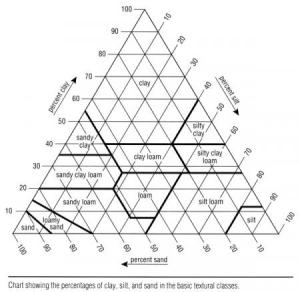
Here in Toowoomba we are very lucky – our soil is a lovely heavy rich clay. The clay soil is rich in nutrients but can become rock-like when they dry out. By determining what a soil contains, it makes it easier to improve the structure, water holding capacity and condition of the soil.
Some soil types include: sand, loamy sand, clayey sand, sandy loam, loam, silty loam, clay loam, light clay, sandy clay, clay….. and the list goes on!
A great way to tell what your soil is ‘made up of ‘ is to do this simple test.
- You will need a glass jar with a screw top lid, such as a pasta jar bottle and a measuring jug.
- On the side of the bottle place a mark 5cms from the base of the bottle.
- Fill the jar with soil to this mark, be sure to pack down the soil gently as it will settle and then pour the soil into the measuring jug.
- The amount of soil, for example 100mls, needs to be doubled to reach the amount needed of water, 200mls.
- Pour the soil into the jar.
- Measure out the water and add this too to the jar. (1 part soil to 2 parts water)
- Put on the lid and shake the mixture vigorously, for about 5 minutes or until all the clumps of soil have dissolved.
- Set the jar onto a level surface and let the contents settle. This may take several hours, so leave it overnight.


When the jar has settled you should see three distinct layers of soil in your jar: sand at the bottom, silt in the middle, and clay on top. Floating near the surface is organic matter. You can measure the thickness of these bands to calculate the percentage of sand, silt, and clay in your soil.
Ideal garden soil should contain enough sand to help with drainage, enough silt to boost mineral richness and enough clay to hold moisture and nutrients. When a soil contains excessive clay the air spaces in the soil are very small, too small for the plant roots and soil microbes to breathe. Water will also have difficulty draining away. On the other hand if a soil contains too much sand it will drain too well and the soil will have difficulty holding nutrients within it.
The best soils contain about 10%–20% clay, and roughly equal proportions of silt and sand. A soil with these optimal proportions is called loam. A good loam also contains plenty of organic matter (as much as 5%–10% in rich soils) to supply nutrients.
I have two samples. One is of the soil from bed 2 and the other is a commercially available garden compost.
The first sample from the garden has 1 cm sand, 2 cm silt and 1 cm clay. Knowing I have 4cm (it settled a bit!) of soil it is easy to work out the % of each layer. 25% sand, 50% silt and 25% clay. This sample is Loam.
The second sample from the compost has 1 cm sand, 1 cm, silt and 1 cm clay. The percentages for this is 33.3% sand, 33.3% silt and 33.3% clay. This sample is a clay loam.

So using the diagram above it can be determined the first sample is a Loam soil and the second sample is a clay loam.
So what type of soil do you have?
Diagram from: http://www.the-compost-gardener.com/soil-texture.html
